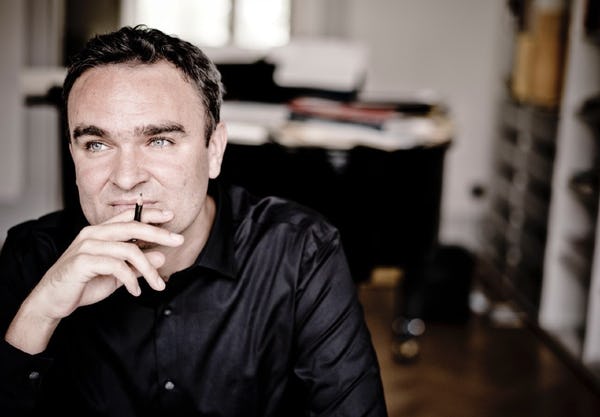Scott Cantrell, special contributor and former classical music critic for the Dallas Morning News, reviews "Jörg Widmann at the Nasher" from the Nasher Sculpture Center's Soundings series:

You'd be hard-pressed to outdo the Nasher Sculpture Center's Soundings series for the most provocative classical-music programs in the area. The formula of setting cutting-edge contemporary music in contexts of older fare was certainly in evidence Sunday evening.
This was the last of three concerts over the weekend featuring the 43-year-old German composer and clarinetist Jörg Widmann. A Friday concert displayed his avant-garde virtuosity on the clarinet; Saturday's program was devoted to his complete string quartets.
On Sunday, baritone William Sharp and pianist and Soundings artistic director Seth Knopp gave the North American premiere of Widmann's 4-year-old song cycle Das heisse Herz (The Fiery Heart). In the first half, Robert Schumann's 1840 song cycle Dichterliebe (Poet's Love) proved a revelatory prelude. Separated by 173 years, the two works illuminated each other.
To words by the poet Heinrich Heine, the Schumann cycle is all about lost love. Words and music explore turbulent emotions stirred up by rejection: sentimentality, heartsickness, defiance, fury and sarcasm. Dreams mix with reality.
Sharp made this a deeply personal experience, coloring and texturing his well-seasoned baritone with drama and sensitivity. As appropriate to both words and music, there were sounds alternately rich, brazen and gently insinuated. Knopp's pianism matched Sharp's expressivity. The compact, low-ceilinged auditorium on the Nasher's lower level has oppressed some music, but here it supplied apt salon-like intimacy.
The piano introduction to Widmann's cycle almost sounded like an echo, subtly distorted, of the opening of Dichterliebe. One of the songs, "Hab' ein Ringelein am Finger" ("I Have a Ring on My Finger"), evoked associations with a parallel song in Schumann's Frauenliebe und Leben. "Liebeslied" ("Love Song") suggested the sardonic tone of Kurt Weill; "Das Fraulein stand am Meere" ("The Girl Stood by the Sea") was set as an irreverent waltz.
Widmann's cycle sets texts from a variety of sources — including Heine — but as with Dichterliebe, the theme is lost love. Here, though, the tone ventures more boldly into irony, sarcasm and even surrealism. Surprisingly, perhaps, the vocal writing is anything but the far-flung spasms of much contemporary European work. No, it has a naturalness of pitch and shape. Although the piano part incorporates angry bass clusters and glinting attacks at the top of the keyboard, it also includes flowing patches not that distant from, yes, Schumann.
If postmodernism is defined by allusions to earlier art, Das heisse Herz is postmodern. It was certainly a deeply engaging experience Sunday evening, unsettling in a powerful and artistically valid way. Sharp brought to it every manner of vocal nuance, but with a core of tonal beauty, even adding a good deal of physicality. Again, Knopp was an incisive and dramatic collaborator. I was glad to be there.
